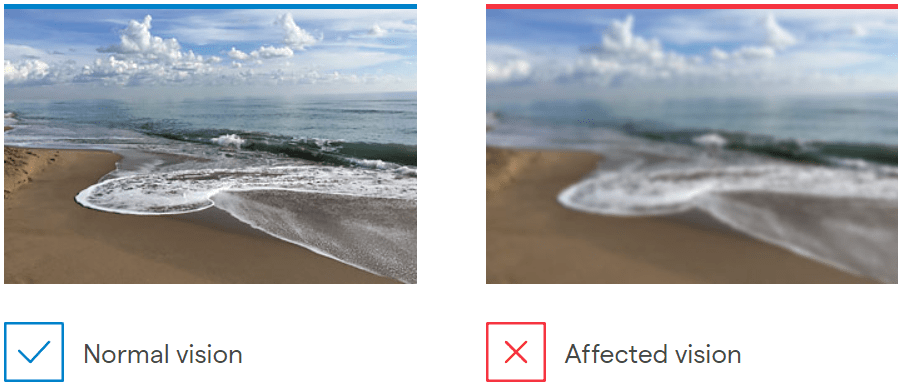Blurred or distorted vision at all distances
12 de April de 2022

Cataracts
A cataract is the loss of transparency of the crystalline lens, the eye’s natural lens located behind the pupil. Rays of light pass through this lens to reach the retina, where images are formed. If the lens loses its transparency and obstructs the passage of light to the retina, the patient suffers from a progressive loss of vision.
The most common symptoms of cataracts are:
- Blurred vision, flashes, poor night vision
- This makes driving at night time difficult, and causes discomfort with light, and changes in prescription strength in glasses
For more information on this disease, click on this link.
How to act?
- Cataracts cannot be prevented, but they can be detected by eye check-ups. It is advisable to see an ophthalmologist regularly, especially after the age of 45, to detect the possible existence of a cataract, its type, size and location, and to determine whether surgery is required and when it should be carried out.
Astigmatism
Astigmatism is a refractive defect that causes images to focus on the retina in a distorted way, affecting near and far vision.
Astigmatism can occur by itself or in association with myopia or hyperopia, and is usually stable throughout life.
Most frequent symptoms
- Perception of distorted images (most common symptom)
- Problems in switching between near and far vision.
- Difficulties in seeing fine detail, either near or distant.
- Headaches, eye pain or dizziness, as a result of the eye’s muscular effort in trying to compensate for the defect with the accommodation of the crystalline lens (the eye’s natural lens whose elasticity enables the eye to focus). This is especially true in cases of astigmatism associated with hyperopia.
For more information on this refractive error, click on this link.
How to act
- Astigmatism can be corrected by glasses or contact lens.
- If the patient prefers not to wear glasses or contact lenses, surgical solutions are available.
- Refractive surgery includes several treatments depending on the diagnosis:
- Excimer laser: applied to the thickness of the cornea, used to correct moderate astigmatism.
- Incisional technique (arcuate keratotomy). consisting of making incisions on the corneal surface, indicated for high astigmatism.
- Toric intraocular lenses: these can be phakic (implanted between the cornea and the crystalline lens) and pseudophakic (replacing the crystalline lens). They are normally used to correct high astigmatism.
IMO Institute of Ocular Microsurgery
Josep María Lladó, 3
08035 Barcelona
Phone: (+34) 934 000 700
E-mail: international@imo.es
See map on Google Maps
By car
GPS navigator coordinates:
41º 24’ 38” N – 02º 07’ 29” E
Exit 7 of the Ronda de Dalt (mountain side). The clinic has a car park with more than 200 parking spaces.
By bus
Autobus H2: Rotonda de Bellesguard, parada 1540
Autobus 196: Josep Maria Lladó-Bellesguard, parada 3191
Autobuses H2, 123, 196: Ronda de Dalt – Bellesguard, parada 0071
How to arrive at IMO from:
IMO Madrid
C/ Valle de Pinares Llanos, 3
28035 Madrid
Phone: (+34) 910 783 783
See map in Google Maps
Public transport
Metro Lacoma (líne 7)
Autobuses:
- Lines 49 & 64, stop “Senda del Infante”
- Line N21, stop “Metro Lacoma”
Timetables
Patient care:
Monday to Friday, 8 a.m. to 8 p.m.
IMO Andorra
Av. de les Nacions Unides, 17
AD700 Escaldes-Engordany, Andorra
Phone: (+376) 688 55 44
See map in Google Maps
IMO Manresa
C/ Carrasco i Formiguera, 33 (Baixos)
08242 – Manresa
Tel: (+34) 938 749 160
See map in Google Maps
Public transport
FGC. Line R5 & R50 direction Manresa. Station/Stop: Baixador de Manresa
Timetables
Monday to Friday, 08:30 A.M – 13:30 PM / 15:00 PM – 20:00 PM




